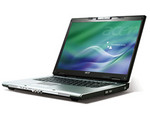Acer TravelMate 4233WLMi
Specifications

Price comparison
Average of 1 scores (from 1 reviews)
Reviews for the Acer TravelMate 4233WLMi
Source: Notebookjournal
 DE→EN Archive.org version
DE→EN Archive.org versionSingle Review, , Length Unknown, Date: 04/18/2007
Rating: Total score: 70% performance: 70% features: 50% display: 30% mobility: 30%
Comment
Intel Graphics Media Accelerator (GMA) 950: Intel Graphics Media Accelerator 950 is an integrated (onboard) graphic chip on Mobile Intel 945GM chipset. It is a faster clocked version of the GMA 900 and supports no hardware T&L (Transform & Lightning) accelleration (which is required for some games).
These graphics cards are not suited for Windows 3D games. Office and Internet surfing however is possible.
» Further information can be found in our Comparison of Mobile Graphics Cards and the corresponding Benchmark List.
Intel Core 2 Duo: This is the Core Duo and Core Solo successor with a longer pipeline and 5-20% more speed without more power consumption. As an addition to the Core Duo design there exists a fourth decoder, an amplified SSE-unit and an additional arithmetical logical unit (ALU).
The Core 2 Duo for laptops is identical to the desktop Core 2 Duo processors but the notebook-processors work with lower voltages (0.95 to 1188 Volt) and a lower Frontside bus clock (1066 vs 667 MHz). The performance of equally clocked notebooks is 20-25% lower than Desktop PCs because of the lower Frontside bus clock and the slower hard disks.
T5500:
Slow clocked dual core processor based on the Merom-2M core without virtualization functions.
» Further information can be found in our Comparison of Mobile Processsors.



